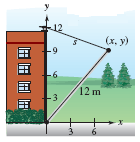
William W. answered • 02/12/22
Experienced Tutor and Retired Engineer
For the bottom right triangle, applying the Pythagorean Theorem yields x2 + y2 = 122 or x2 = 144 - y2
For the upper right triangle, applying the Pythagorean Theorem yields x2 + (12 - y)2 = s2 and substituting "144 - y2" for x2 (from the bottom right triangle), we get:
(144 - y2) + (12 - y)2 = s2
144 - y2 + 144 - 24y + y2 = s2
288 - 24y = s2
4(72 - 6y) = s2
s = √[4(72 - 6y)]
s = 2√(72 - 6y)
s = 2(72 - 6y)1/2
Taking the derivative with respect to time "t" we get:
ds/dt = 1/2(2)(72 - 6y)-1/2(-6)(dy/dt)
ds/dt = -6(dy/dt)/(72 - 6y)1/2
(ds/dt)(72 - 6y)1/2/(-6) = dy/dt
Plugging in s = -0.1 and y = 4 we get:
dy/dt = (-0.1)(72 - 6(4))1/2/(-6)
dy/dt = (-0.1)(72 - 24)1/2/(-6)
dy/dt = (0.1)(48)1/2/6
dy/dt ≈ 0.11547 or, rounding: dy/dt = 0.115 m/sec
To find dx/dt. let's go back to x2 + y2 = 144 and take the derivative implicitly:
2x•dx/dt + 2y•dy/dt = 0
x•dx/dt + y•dy/dt = 0
x•dx/dt = -y•dy/dt
dx/dt = -y/x•dy/dt
If y = 4, we can solve for x to get x = √(144 - 42) = 11.3137 so:
dx/dt = -4/11.3137•( 0.11547) = -0.04082 or, rounding: dx/dt = -0.041 m/sec





